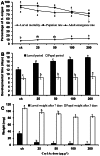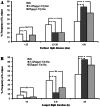Increased long-flight activity triggered in beet armyworm by larval feeding on diet containing Cry1Ac protoxin
- PMID: 23675489
- PMCID: PMC3652841
- DOI: 10.1371/journal.pone.0063554
Increased long-flight activity triggered in beet armyworm by larval feeding on diet containing Cry1Ac protoxin
Abstract
Evaluating ecological safety and conducting pest risk analysis for transgenic crops are vitally important before their commercial planting. The beet armyworm, Spodoptera exigua, a long-distance migratory insect pest, is not a direct target of transgenic Cry1Ac-expressing cotton in China, but nevertheless it has recently become an important pest. Migrants leaving their natal field arrive in other appropriate habitat far away in a short time, often followed by larval outbreaks. S. exigua has low susceptibility to Cry1Ac. However, our results from laboratory experiments identified (i) sublethal effects of Cry1Ac protoxin on larval development rate, larval and pupal weight, and adult lifetime fecundity, and (ii) increased long-flight behavior triggered by Cry1Ac which may contribute to larval outbreaks elsewhere. No significant differences in larval mortality, pupation rate, adult emergence rate, longevity, pre-oviposition period, or oviposition period were observed between controls and larvae fed on artificial diet incorporating a low concentration of Cry1Ac protoxin. The negative sublethal effects on some developmental and reproductive traits and lack of effect on others suggest they do not contribute to the observed severity of S. exigua outbreaks after feeding on Cry1Ac cotton. Interestingly, the percentage of long fliers increased significantly when larvae were reared on diet containing either of two low-dose treatments of Cry1Ac, suggesting a possible increased propensity to disperse long distances triggered by Cry1Ac. We hypothesize that negative effects on development and reproduction caused by Cry1Ac in the diet are offset by increased flight propensity triggered by the poor food conditions, thereby improving the chances of escaping adverse local conditions before oviposition. Increased long-flight propensity in turn may amplify the area damaged by outbreak populations. This phenomenon might be common in other migratory insect pests receiving sublethal doses of Bt toxins and warrants further study.
Conflict of interest statement
Figures




Similar articles
-
Fall Armyworm (Lepidoptera: Noctuidae) Development, Survivorship, and Damage on Cotton Plants Expressing Insecticidal Plant-Incorporated Protectants.J Econ Entomol. 2015 Jun;108(3):1086-93. doi: 10.1093/jee/tov092. Epub 2015 Apr 29. J Econ Entomol. 2015. PMID: 26470233
-
Toxicity and characterization of cotton expressing Bacillus thuringiensis Cry1Ac and Cry2Ab2 proteins for control of lepidopteran pests.J Econ Entomol. 2008 Apr;101(2):546-54. doi: 10.1603/0022-0493(2008)101[546:tacoce]2.0.co;2. J Econ Entomol. 2008. PMID: 18459423
-
Interactions of Bacillus thuringiensis Cry1Ac toxin in genetically engineered cotton with predatory heteropterans.Transgenic Res. 2008 Jun;17(3):345-54. doi: 10.1007/s11248-007-9109-8. Epub 2007 Jun 15. Transgenic Res. 2008. PMID: 17570072
-
Early detection of field-evolved resistance to Bt cotton in China: cotton bollworm and pink bollworm.J Invertebr Pathol. 2012 Jul;110(3):301-6. doi: 10.1016/j.jip.2012.04.008. Epub 2012 Apr 16. J Invertebr Pathol. 2012. PMID: 22537835 Review.
-
Fitness and mating compatibility of Rachiplusia nu strains exposed to soybean expressing Cry1Ac in Argentina.Bull Entomol Res. 2025 Feb 17:1-9. doi: 10.1017/S0007485325000069. Online ahead of print. Bull Entomol Res. 2025. PMID: 39957052 Review.
Cited by
-
Exposure to Cry1 Toxins Increases Long Flight Tendency in Susceptible but Not in Cry1F-Resistant Female Spodoptera frugiperda (Lepidoptera: Noctuidae).Insects. 2023 Dec 22;15(1):7. doi: 10.3390/insects15010007. Insects. 2023. PMID: 38249013 Free PMC article.
-
Biocontrol of the oriental armyworm, Mythimna separata, by the tachinid fly Exorista civilis is synergized by Cry1Ab protoxin.Sci Rep. 2016 Jun 21;6:26873. doi: 10.1038/srep26873. Sci Rep. 2016. PMID: 27324469 Free PMC article.
-
Sublethal Effects of Diamide Insecticides on Development and Flight Performance of Chloridea virescens (Lepidoptera: Noctuidae): Implications for Bt Soybean Refuge Area Management.Insects. 2020 Apr 28;11(5):269. doi: 10.3390/insects11050269. Insects. 2020. PMID: 32354195 Free PMC article.
-
Seasonal Migratory Activity of the Beet Armyworm Spodoptera exigua (Hübner) in the Tropical Area of China.Insects. 2024 Dec 12;15(12):986. doi: 10.3390/insects15120986. Insects. 2024. PMID: 39769588 Free PMC article.
-
Biotoxicity of Cry1Ab protein on wolf spider Pardosa pseudoannulata.Ecotoxicology. 2017 Dec;26(10):1336-1343. doi: 10.1007/s10646-017-1858-4. Epub 2017 Oct 17. Ecotoxicology. 2017. PMID: 29043472
References
-
- Naranjo SE (2011) Impacts of Bt transgenic cotton on integrated pest management. J Agr Food Chem 2 59: 5842–51. - PubMed
-
- Qaim M, Zilberman D (2003) Yield effects of genetically modified crops in developing countries. Science 299: 900–902. - PubMed
-
- Qaim M (2009) The economics of genetically modified crops. Annu Rev Res Econ 1: 665–693.
-
- Lu YH, Wu KM, Jiang YY, Guo YY, Desneux N (2012) Widespread adoption of Bt cotton and insecticide decrease promotes biocontrol services. Nature doi:10.1038/nature11153. - PubMed
-
- Wu KM, Lu YH, Feng HQ, Jiang YY, Zhao JZ (2008) Suppression of cotton bollworm in multiple crops in China in areas with Bt toxin containing cotton. Science 5896: 1676–1678. - PubMed
Publication types
MeSH terms
Substances
LinkOut - more resources
Full Text Sources
Other Literature Sources

